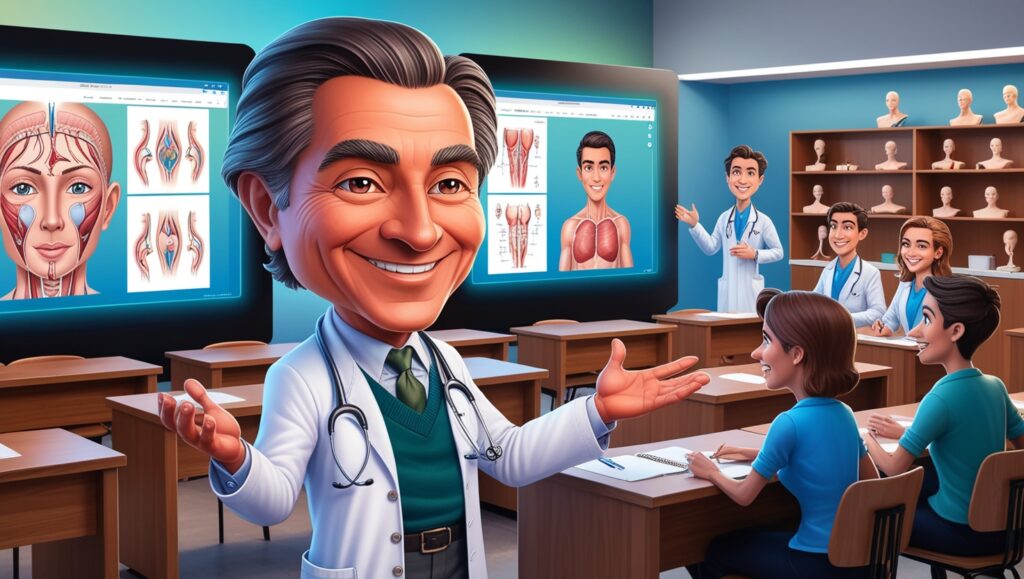E-Learing platform for
Master in Aesthetic Medicine and Therapeutics
|
Our Vision Medicine for All

Currently there is no universally accepted definition for aesthetic medicine/surgery. This branch of medicine is growing and is often defined as cosmetic medicine or even, creating a certain amount of confusion, as aesthetic surgery. In general, aesthetic medicine involves simple dermatological and hair thickening procedures, the enhancement (with volumization) of certain body structures and interventions to counteract phenomena that are accompanied by changes in appearance due to the aging process. It is interesting to consider the similarities and differences between conventional medicine and aesthetic medicine.
Conventional medicine has at least four characteristics, as follows:
- The objectives of medicine are treatment and prevention.
- The medical scientific approach based on evidence is the foundation for the execution of interventions.
- The professionalism of the operator is based on skills and informed consent.
- The involvement of healthcare professionals from various disciplines is complementary and not competitive.
Course details
Aesthetic medicine procedures, on the other hand, are minimally invasive and can be performed in a doctor’s office. Another branch of aesthetic surgery is reconstructive surgery. This type of surgery consists of procedures on abnormal structures of the body caused by congenital defects, developmental abnormalities, trauma, infections, tumors or diseases. It is generally performed to improve function but can also be performed to improve the individual’s appearance.
Features
Comprehensive Course Content
The Master in Aesthetic Medicine and Therapeutics is aimed at offering to professionals graduated in Medicine and Surgery or in Dentistry the bases for a correct and fruitful practice in the field of aesthetic medicine.
Medicine has been defined as “the science of the diagnosis, treatment or prevention of disease and other harm to the body or mind”. For aesthetic medicine, the basic problem is not abnormal structures per se, but rather, the patient is dissatisfied with the appearance of parts of his or her body, and so turns to the health care provider to improve it.
From this point of view, aesthetic medicine is not conventional. The field of application of aesthetic medicine is quite broad and the term aesthetic medicine should not be considered synonymous with cosmetic surgery. For a more precise distinction between aesthetic medicine and surgery, we consider that procedures and techniques that require the application of the surgeon's skills, the use of the operating room and an anesthetic facility belong to cosmetic surgery.
Plastic surgery includes both aesthetic surgery and reconstructive surgery. However, there are “gray areas” of procedures that can be reconstructive or cosmetic (aesthetic), depending about each patient. For example, eyelid surgery (blepharoplasty) - a procedure normally performed to obtain an aesthetic improvement - can also be performed if the eyelids narrow the visual field and reduce a person's visual acuity.
In general, however, the focus in aesthetic medicine is on the treatment of normal structures to improve appearance and self-esteem. Obviously, the patient and safety must remain the primary consideration, but, in any case, if there is no disease to be treated, the burden of “primum non nocere” will certainly be more relevant.
In general, medical-aesthetic interventions are:
Performed to remodel normal body structures.
Performed at the request of the patient and not for medical necessity.
Performed without the use of surgical techniques or general anesthesia.
To reconcile this phenomenon with the conventional objectives of medicine, we will need a broader definition of health, such as the definition of the World Health Organization (WHO) which includes, for the complete well-being of the individual, not only the physical but also the social and mental dimensions of health.
Students who have paid their fees in full and attended at least 75% of the Master's activities will be eligible to sit for the first-year final exam consisting of both a written and an oral examination.
The Master course will include intermediate tests at the end of each of the four months.
After completing the final exam and the course evaluation questionnaire, the Universities of Camerino and Turin, jointly, will issue a University 2nd Level Master Diploma.
Upon completion of the Master's program, only those students who have paid their fees in full and have attended at least 75% of the face-to-face classes will be allowed to sit the final exam
